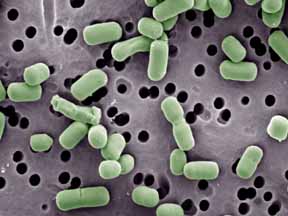The translucent crystals which are formed from Dextran (A complex branched glucan or polysaccharide formed from many glucose molecules), make up the bulk of what you see as grains. These grains are created by the lactic acid bacterium Lactobacillus brevis.
Medicinally, Dextran is used as an antithrombotic (anti-platelet) in order to reduce blood viscosity and also as a volume expander for those with anemia.
As this complex system of organisms function together as Water Kefir however, there are multiple beneficial uses for them from creating probiotic drinks to improve ones digestion and absorption of specific vitamins and minerals to fermenting fruits and vegetables for consumption.
Here we shall look at the Lactobacilli bacterium present in the majority of Water Kefir Grains.
Lactobacilli bacterium
Lactobacillus galactose
Lb. brevis
Lb. casei subsp. casei
Lb. paracasei subsp. paracasei
Lb. casei subsp. Ramos
Lb. casei subsp. tolerant
Lb. coraciiform subsp. torquens
Lb. fructose
Lb. hilarities
Lb. homophobia
Lb. plantarum
Lb. pseudo plantarum
Lb. admonishes
Lactobacillus galactose
The ability to ferment galactose is a major characteristic which can be used to differentiate Lactobacillus helveticus (galactose positive) from Lactobacillus lactis and Lactobacillus bulgaricus (galactose negative). In milk cultures, galactose-positive strains produced d- and l-lactic acid with little galactose accumulation, whereas galactose-negative strains produced d-lactic acid, and galactose accumulated to high levels.
Galactose (from the Greek stem γάλακτ– galakt–, "milk"), sometimes abbreviated Gal, is a monosaccharide sugar that is less sweet than glucose. It is a C-4 epimer of glucose. Some ongoing studies suggest galactose may have a role in treatment of focal segmental glomerulosclerosis (a kidney disease resulting in kidney failure and proteinuria).[citation needed] This effect is likely to be a result of binding of galactose to FSGS factor.[citation needed]
Galactose is a component of the antigens present on blood cells that determine blood type within the ABO blood group system. In O and A antigens, there are two monomers of galactose on the antigens, whereas in the B antigens there are three monomers of glucose.
Lactobacillus brevis

Lactobacillus brevis is a species of lactic acid bacteria, all of which are Gram-positive, non spore forming organisms whose main metabolic pathway involves fermenting hexose sugars to produce lactic acid.
Lactobacillus brevis and the Lactobacilli in general, are Gram-positive, rod-shaped, non spore forming bacteria arranged in singles. This implies a thick cell wall and an inner membrane in its rod shape. Although the sequenced genome of L. brevis is relatively small, the lactic acid bacteria can encode a multitude of different transporters to fulfill the needs of both prototrophic and auxotrophic strains.(3) L. brevis bacteria are aerobe bacteria, they are motile, and probiotic.(4)
Fermentation is the one most common pathway in L. brevis and most other lactic acid bacteria. In this metabolic pathway, sugar (hexoses) is converted to lactic acid by the 6-phosphogluconate pathway, producing also CO2 and ethanol.(2) Energy (ATP) is generated along the way by non-oxidative substrate level phoshorylation. The final product of fermentation, lactic acid contributes to production of such foods as cheese, yogurt, fermented milks and others by inhibiting the growth of other organisms and lowering the pH of the products. Along the pathway, many metabolic reactions occur, one of them being the breakdown of milk products for cheese production. L. brevis specifically is used in industrial production to act as a starter culture for several types of beer and sourdough bread.(4)
Fermentation is the one most common pathway in L. brevis and most other lactic acid bacteria. In this metabolic pathway, sugar (hexoses) is converted to lactic acid by the 6-phosphogluconate pathway, producing also CO2 and ethanol.(2) Energy (ATP) is generated along the way by non-oxidative substrate level phoshorylation. The final product of fermentation, lactic acid contributes to production of such foods as cheese, yogurt, fermented milks and others by inhibiting the growth of other organisms and lowering the pH of the products. Along the pathway, many metabolic reactions occur, one of them being the breakdown of milk products for cheese production. L. brevis specifically is used in industrial production to act as a starter culture for several types of beer and sourdough bread.(4)
One of the most interesting interactions is that with the human intestinal flora. Lactobacillus, when ingested, has probiotic effects as it improves the immune system.(8)
Also, currently there are studies and research conducted on L. brevis and other lactic acid bacteria for incorporation into bio fuels and other environmental friendly and efficient materials.(8)
Lactobacillus casei subsp. casei

We have reported previously that Lactobacillus casei ssp. casei, together with specific substrate dextran, exhibited an adjuvant effect of stimulating humoral immune responses against bovine serum albumin (BSA) as a model antigen in BALB/c mice. In the present study, among the Lactobacillus species tested, L. casei ssp. casei with dextran significantly elevated the natural killer (NK) cell activities in spleen mononuclear cells from BALB/c mice in comparison to L. casei ssp. casei alone or other Lactobacillus species with or without dextran. Oral administration of L. casei ssp. casei together with dextran also resulted in a significant increase of NK cell activities in healthy human volunteers. Further, L. casei ssp. casei induced significant production of interleukin (IL)-12 in human peripheral blood mononuclear cells and IL-15 mRNA expression in the human intestinal epithelial cell line Caco-2. L. casei ssp. casei with dextran in food also significantly elevated the survival rate of BALB/c mice bearing Meth-A cells. Taken together, these results demonstrate that dietary synbiotic supplementation which is a combination of the L. casei ssp. casei used as a probiotic together with the dextran, a specific substrate as a prebiotic, efficiently elicits murine and human NK cell activities.
Sources:
http://users.sa.chariot.net.au/~dna/kefirpage.html#alternativekefir
http://en.wikipedia.org/wiki/Dextran
http://www.ncbi.nlm.nih.gov/pubmed/16346322
http://en.wikipedia.org/wiki/Galactose
http://microbewiki.kenyon.edu/index.php/Lactobacillus_brevis
http://www.ncbi.nlm.nih.gov/pubmed/16367940
No comments:
Post a Comment